Galls or cecidia are a kind of swelling growth on the external tissues of plants. Plant galls are abnormal outgrowths of plant tissues, similar to benign tumors or warts in animals. They can be caused by various parasites, from viruses, fungi and bacteria, to other plants, insects and mites. Plant galls are often highly organized structures so that the cause of the gall can often be determined without the actual agent being identified. This applies particularly to insect and mite plant galls. The study of plant galls is known as cecidology.

Diplolepis is a genus of approximately fifty species of gall-inducing wasps in the family Diplolepididae. The larvae induce galls on wild roses (Rosa), and rarely on domestic roses.
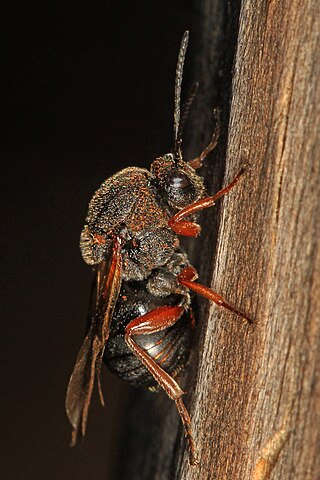
Gall wasps, also traditionally calledgallflies, are hymenopterans of the family Cynipidae in the wasp superfamily Cynipoidea. Their common name comes from the galls they induce on plants for larval development. About 1,300 species of this generally very small creature are known worldwide, with about 360 species of 36 different genera in Europe and some 800 species in North America.

Andricus foecundatrix is a parthenogenetic gall wasp which lays a single egg within a leaf bud, using its ovipositor, to produce a gall known as an oak artichoke gall, oak hop gall, larch-cone gall or hop strobile The gall develops as a chemically induced distortion of leaf axillary or terminal buds on pedunculate oak or sessile oak trees. The larva lives inside a smaller hard casing inside the artichoke and this is released in autumn. The asexual wasp emerges in spring and lays her eggs in the oak catkins. These develop into small oval galls which produce the sexual generation of wasps. A yew artichoke gall caused by the fly Taxomyia taxi also exists, but is unrelated to the oak-borne species. Previous names or synonyms for the species A. fecundator are A. fecundatrix, A. pilosus, A. foecundatrix, A. gemmarum, A. gemmae, A. gemmaequercus, A. gemmaecinaraeformis and A. quercusgemmae.

Diplolepis rosae is a gall wasp which causes a gall known as the rose bedeguar gall, bedeguar gall wasp, Robin's pincushion, mossy rose gall, or simply moss gall. The gall develops as a chemically induced distortion of an unopened leaf axillary or terminal bud, mostly on field rose or dog rose shrubs. The female wasp lays up to 60 eggs within each leaf bud using her ovipositor. The grubs develop within the gall, and the wasps emerge in spring; the wasp is parthenogenetic with fewer than one percent being males.
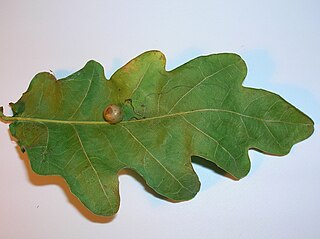
The red-pea gall or red currant gall develops as a chemically induced distortion arising from the underside of the mid-rib of a vein on Quercus species and it is attached by a short stalk or peduncle. The red-wart gall is the sexual phase of the same species.

Cynipinae is a subfamily of gall wasps (Cynipidae). Many of the approximately 1,500 described species cause galls on oaks, but some induce galls on other plant species or are inquilines of the gall-inducing species. Species occur on all continents except Antarctica, with most found in the temperate regions of the northern hemisphere. All extant cynipid species are within Cynipinae since the only other recognized subfamily is Hodiernocynipinae which is based on the fossil genus Hodiernocynips.
Andricus opertus, the fimbriate gall wasp, is a species of wasp in the family Cynipidae whose bisexual generation induces elongate, spiky galls on the leaves of various species of oaks in California, including valley oak and scrub oak. The galls of the bisexual generation form in spring, adults emerge in late spring, and galls persist on trees until the fall. The unisexual generation of this species forms aborted bud galls in the summer and fall.

Diplolepis mayri is a gall inducing insect causing galls on wild roses in the Western Palaearctic. Diploleis mayri is less frequent on rose shrubs than D. rosae.
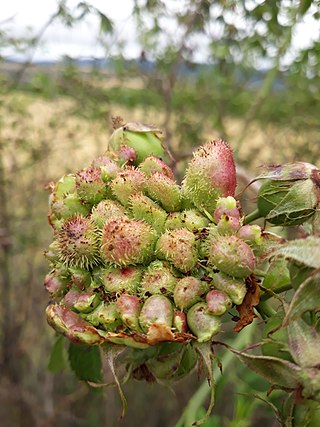
Diplolepis fructuum is a hymenopteran gall wasp which causes a galls on wild roses. The species is closely related to D. rosae and D. mayri but it produces its galls in the seeds of wild roses thus damaging its hips. The species is distributed mainly in the Northern regions of the Middle East, the Caucasus region and Northern shores of the Black Sea.

Diplolepis polita, known generally as the spiny leaf gall wasp, is a species of gall wasp in the family Cynipidae. It was first described by William Harris Ashmead in 1890.

Diplolepis ignota is a species of gall wasp (Cynipidae). Galls in which the larvae live and feed are formed on the leaves of several species of wild rose (Rosa). Individual galls are single-chambered and spherical, but multiple galls can coalesce into irregularly rounded galls.

Cynips quercusechinus, the urchin gall wasp, is a species of gall wasp in the family Cynipidae. It induces galls in the leaves and leaf buds of blue oak and scrub oak. Like other oak gall wasps, it has two generations: a bisexual generation, and a parthenogenic female generation. In spring, the hatching bisexual generation produces hollow green galls in leaf buds. In summer, the unisexual generation induces its galls, which are red or pink and resemble sea urchins, on the undersides of leaves. These galls are about 10 millimetres (0.39 in) in diameter. The galls fall with the leaves in autumn, and the larvae inside of them emerge as adults in the spring and lay their eggs.

Diplolepis californica, formerly Rhodites californicus, also known as the leafy bract gall wasp, is a species of cynipid wasp that induces galls on wild roses on the Pacific coast of North America. D. californica induces club-shaped bud galls that naturalist Richard A. Russo describes as "distinguished from all others by the flat, leafy lobes that emanate from the main gall body and look like aborted leaflets". Each gall contains multiple larval chambers. One of host plants of the leafy bract gall wasp is Rosa californica.
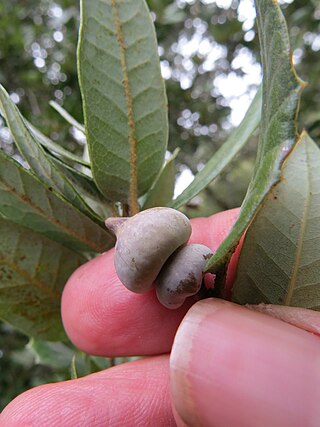
Heteroecus sanctaeclarae, also known as the mushroom gall wasp, is a species of cynipid wasp that induces galls on huckleberry oaks and canyon live oaks on the Pacific coast of North America.
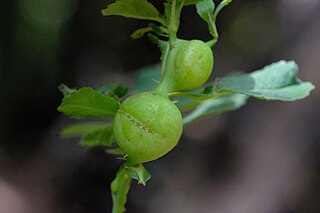
Diplolepis nodulosa, also known as the rose-stem gall wasp, is a species of cynipid wasp that induces bud galls on wild roses in North America. This galls induced by this species have a number of inquilines and parasitoids. D. nodulosa is assigned to a clade of Nearctic stem gallers within Diplolepis along with Diplolepis californica, Diplolepis oregonesis, Diplolepis spinosa, and Diplolepis triforma.

Diplolepis bassetti, also known as the mossy rose gall wasp, is a species of cynipid wasp that induces bud galls on wild roses in North America. Hosts include interior rose, Nootka rose, and pine rose.

Diplolepididae is a family of small gall-inducing wasps. Until recently these wasps were included in the gall wasp family (Cynipidae) but were moved to their own family based on genetic and morphological features. It contains two subfamilies: Diplolepidinae and Pediaspidinae.














